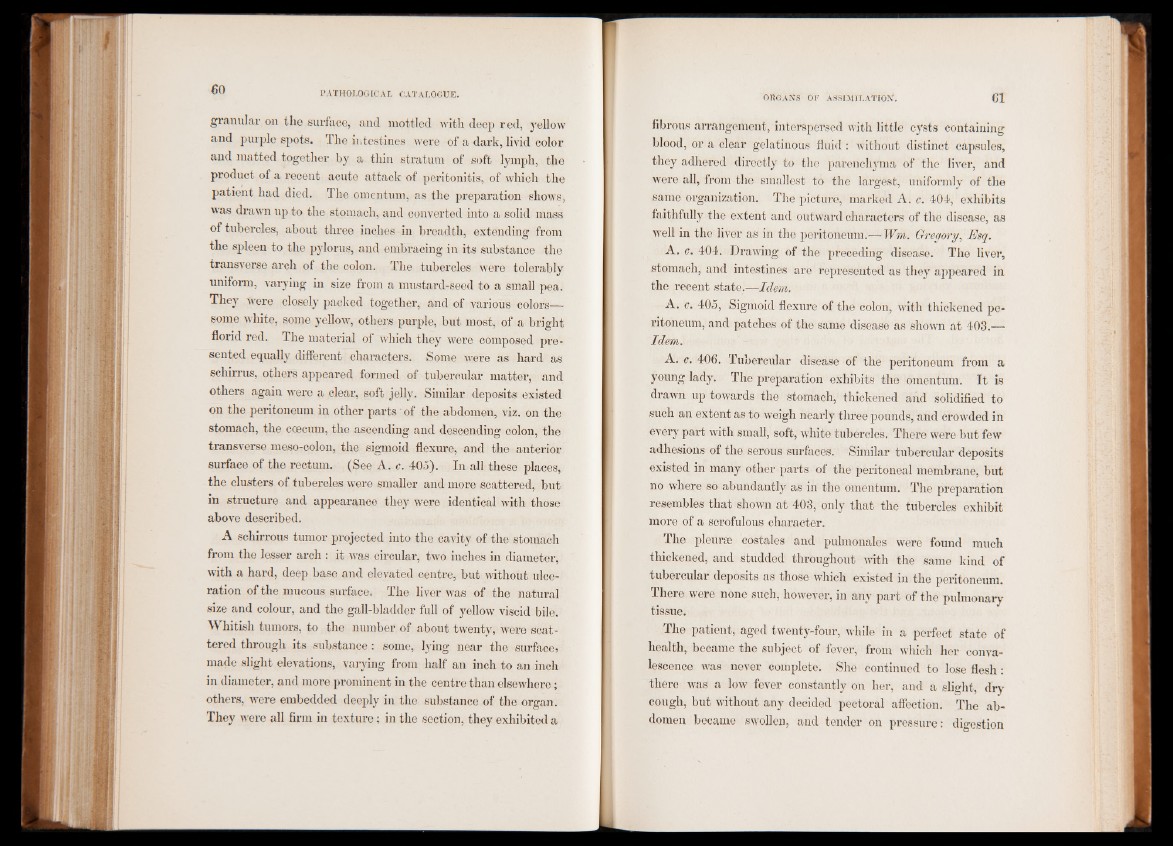
granular on the surface, and mottled with deep red, yellow
and purple spots. The intestines were of a dark, livid color
and matted together by a thin stratum of soft lymph, the
product of a recent acute attack of peritonitis, of which the
patient had died. The omentum, as the preparation shows,
was drawn up to the stomach, and converted into a solid mass
of tubercles, about three inches in breadth, extending from
the spleen to the pylorus, and embracing in its substance the
transverse arch of the colon. The tubercles were tolerably
uniform, varying in size from a mustard-seed to a small pea.
They w°re closely packed together, and of various colors—
some white, some yellow, others purple, but most, of a bright
florid red. The material of which they were composed presented
equally different characters. Some were as hard as
schirrus, others appeared formed of tubercular matter, and
others again were a clear, soft jelly. Similar deposits existed
on the peritoneum in other parts of the abdomen, viz. on the
stomach, the cæcum, the ascending and descending colon, the
transverse meso-eolon, the sigmoid flexure, and the anterior
surface of the rectum. (See A. c. 405). In all these places,
the clusters of tubercles were smaller and more scattered, but
in structure and appearance they were identical with those
above described.
A schirrous tumor projected into the cavity of the stomach
from the lesser arch : it was circular, two inches in diameter,
with a hard, deep base and elevated centre, but without ulceration
of the mucous surface. The liver was of the natural
size and colour, and the gall-bladder full of yellow viscid bile.
Whitish tumors, to the number of about twenty, were scattered
through its substance : some, lying near the surface»
made slight elevations, varying from half an inch to an inch
in diameter, and more prominent in the centre than elsewhere ;
others, were embedded deeply in the substance of the organ.
They were all firm in texture ; in the section, they exhibited a
fibrous arrangement, interspersed with little cysts containing
blood, or a clear gelatinous fluid : without distinct capsules,
they adhered directly to the p a r e n c h y m a of the liver, and
were all, from the smallest to the largest, uniformly of the
same organization. The picture, marked A. c. 404, exhibits
faithfully the extent and outward characters of the disease, as
well in the liver as in the peritoneum.— Wm. Gregory, Esq.
A. c. 404. Drawing of the preceding disease. The liver,
stomach, and intestines are represented as they appeared in
the recent state.—Idem.
A. c. 405, Sigmoid flexure of the colon, with thickened pe*
ritoneum, and patches of the same disease as shown at 403.—
Idem.
A. c. 406. Tubercular disease of the peritoneum from a
young lady. The preparation exhibits the omentum. It is
drawn up towards the stomach, thickened and solidified to
such an extent as to weigh nearly three pounds, and crowded in
every part with small, soft, white tubercles. There were but few
adhesions of the serous surfaces. Similar tubercular deposits
existed in many other parts of the peritoneal membrane, but
no where so abundantly as in the omentum. The preparation
resembles that shown at 403, only that the tubercles exhibit
more of a scrofulous character.
The pleurie costales and pulmonales were found much
thickened, and studded throughout with the same kind of
tubercular deposits as those which existed in the peritoneum.
There were none such, however, in any part of the pulmonary
tissue.
The patient, aged twenty-four, while in a perfect state of
health, became the subject of fever, from which her convalescence
was never complete. She continued to lose flesh:
there was a low fever constantly on her, and a slight, dry
cough, but without any decided pectoral affection. The abdomen
became swollen, and tender on pressure: digestion